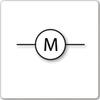Whole Course Flashcards
(461 cards)
Describe how a cyclist can streamline themself
- Crouch over the handlebars
- Wear tight lycra clothing
- Specially shaped helmet
What is meant by capacitance?
Charge stored per unit volt
An astronaut has a mass of 50kg. What will happen to the astronauts weight on the Moon?
The weight will decrease as there is a lower gravitaional field strength on the Moon.
Explain how a fusion reactor could generate electrical energy.
- At high temperature and pressure small nuclei join together
- This releases huge amounts of heat energy (Nuclear to Heat)
- The heat energy is used to heat water to steam.
- The steam is used to turn a turbine. (Heat to Kinetic)
- The turbine is used to turn a generator. (Kinetic to Electrical)
What is the energy change in a battery?
Chemical to electrical
Which circuit component is represented by the following diagram?

MOSFET
What is an asteroid?
An asteroid is a small rocky and airless object that orbit the sun. They are too small to be planets.
What will absorb beta radiation?
A few millimetres of aluminium
How can you tell from this oscilloscope image that this is AC?

The trace shows a change in direction
What are the issues of pressure differential?
Pressure in space is so low it is almost zero. Space suits and pressurised space craft are required to protect astronauts otherwise they would lose conciousness and suffocate or their blood could boil.
What happens if light is shone onto a surface at an angle greater than the critical angle?
It is no longer refracted it is totally internally reflected.
What happens to a light ray as it travels from water into air?
It speeds up and changes direction away from the normal.
What does the path a projectile takes look like?
Curve

What is the difference between mass and weight?
Mass is a measure of the partcles that make an object up. Weight is a force caused by the gravitational field strength of a planet.
What is the rule for voltages in a parallel circuit?
The voltage across each branch is equal to the supply voltage.
Why is maintaining energy such a big issue in space exploration?
Energy is required to maintain life support systems. It would be difficult to carry enough fuel so energy must be generated in space.
Name one source of AC
Mains supply
What is speed?
Distance travelled per second.
How should a diode or LED be connected with a battery to light correctly?
Small line on battery points to small line on LED or diode.

What is conservation of energy?
Energy cannot be created or destroyed it can only be transferred from one type to another.
What is the charge on an electron?
Negative
State one source of visible light.
- The Sun
- Light bulbs
- Anything hot enough to glow
What would the field lines around a positive point charge look like?
Field lines show direction away from the positive point charge.

Which component does the symbol represent?

Buzzer













































































































































